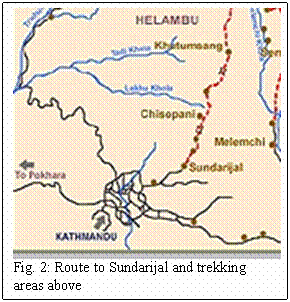Pioneers like the Grameen didn't bring people to a bank, they brought a bank to the people. This simple yet most powerful reorientation in thinking is what developing countries need more than ever before. But, development after all is meaningful and can be sustained when different components of it work in an interactive and integrated fashion. The proposed idea here, for example, is to do just that by incorporating information technology and P2P microfinance mechanism to integrate education and skill training, finance, health, and the environment. (See the integrative flowchart)
An Over View of Sundarijal
1.1 General Background
Sundarijal is one of the 57 VDCs of Kathmandu District. It is situated about 15 km North-east of Kathmandu city. The VDC is named after the Hindu goddess ‘Sundarimai’. The temple of ‘Sudarimai’ is located about 3 km north from the headquater of the VDC. The total area of this VDC is 10,752.13 ropanis (5.18 km 2). Most of the land of the VDC is covered by hills and forests. Only some part is plain terrain. Shivapuri National Park covers a major portion of the VDC.
1.2 Physiography and climate
The VDC is located West to Gagalphedi VDC and East to Nayapati & Baluwa VDCs. Towards its South lies Aalapot VDC and at its Norther portion touches the boundaries of Nuwakot and Sindhupalchowk districts. The climate is of Temperate type. During summer, the temperature is 25.5 ˚ C in average and temperature drops down even to 0 ˚ C during winter.
The buses ply up to the bus park situated at the main market of the VDC and other places are linked by the narrow earthen roads, link roads and foot trails. The main villages of the VDC are Kune, Majhgaun, Chilaune, Okhani, Mulkharka, Mahankal, and Ghatte Khola gaun.
1.3 River system
Bagmati River originates from Baghdwar situated at the Baluwa VDC and passes through the Sundarijal VDC along Nayapati and Gagalbhedi areas of the VDC. The other rivers that flow through the VDC are Shyalmati River and Nagmati River . A 640 kW Hydropower plant situated near the bus park area has provided power supply for electricity distribution in all the nine wards of the VDC.
1.4 Population, Settlement and Land use
The total population of the VDC is 1,586. There are only 444 households in the VDC. Most of the people are Tamangs and Buddhists predominate the region.
Table 1: Population of Sundarijal VDC
Ward No. |
Households |
Male |
Female |
Total Population |
1 |
30 |
86 |
88 |
174 |
2 |
104 |
278 |
295 |
573 |
3 |
51 |
117 |
118 |
235 |
4 |
54 |
113 |
136 |
249 |
5 |
37 |
149 |
105 |
254 |
6 |
32 |
89 |
86 |
175 |
7 |
35 |
95 |
105 |
200 |
8 |
35 |
175 |
132 |
307 |
9 |
66 |
209 |
210 |
419 |
|
444 |
1311 |
1275 |
2586 |
Source; CBS, 2001
Table 2: Major Castes of Sundarijal VDC
SN |
Castes |
Percentage |
1 |
Chhetriyas/Brahmins |
30 |
2 |
Tamangs |
60 |
3 |
Newars |
10 |
|
Total |
100 |
Table 3: Major Religions of Sundarijal VDC
SN |
Religion |
Percentage |
1 |
Buddhists |
60 |
2 |
Hindu |
40 |
|
Total |
100 |
Most of the land is covered by forest and hills.
Table 4: Major Religions of Sundarijal VDC
SN |
Land Use/Type |
Area (ropanis) |
1 |
Agricultural land |
1,076.00 |
2 |
Forest and hills |
9,676.13 |
|
Total |
10,752.13 |
Almost 90% of the VDC comes under the upstream areas where the Tamang communities predominate. They grow millet and maize in the upstream areas. However, some vegetables and barley are also cultivated. Most of them are engaged in hoarding livestock while some are seen involved in small business like shops and hotels.
In the downstream areas, wheat, barley, maze, potato, vegetables and millet are grown. The majority of the people are Chhetriyas, Bahuns, and Newars. Some of them are involved in governmental and non-governmental services while most of them are involved in agriculture and business.
1.5 Cultural heritage and tourism
‘Sundarimai Mandir ( Temple )’, Ganesh Mandir and Krishna Mandir are the main cultural sites here. People from Kathmandu and other places go to Sundarijal for visiting these temples. All the Hindu and Buddhist festivals are celebrated. Additionally, during the month of July, ‘Dashahara’ fate/festival is celebrated at the spots near waterfalls and rivers near the temples.

Sundarijal is a tourism area. Here foreigners and well as internal tourists are attracted due to its pristine natural beauty with rivers, streams and small waterfalls. The presence of Shivapuri National Park (114 km 2) has also attracted the visitors to this place. It is also the starting point for the tourists who go for trekking towards Helambu ( Langtang Range ). The people of Kathmandu valley are attracted to the place as it is only about one hour-drive to the place. There are some picnic spots arranged as well.
1.6 Biodiversity
The VDC lies in a transition zone between subtropical and temperate climates. The vegetation consists of a variety of natural forest types including pine, oak, rhododendron etc, depending on altitude and aspect. Recorded wildlife in the area includes mammalian species such as Himalayan Black bear, leopard, jungle cat, and rhesus monkey. There is also home to 177 species of birds, including at least 9 threatened species, 102 species of butterflies with a number of rare and endangered species, and 129 species of mushroom.
1.7 Local Economy and Education
The economic condition of the VDC is not strong. The agricultural land is present only in ward number 8. No major industry is present in the area. Animal hoarding is also not done in large farming scales. No modern technology of farming has been yet introduced. The people are using traditional means of farming agricultural.
Only 50% can read or write, but they aren’t all fully literate. Young generation people of age lesser than 25 years are educated while the people of age over 40 years are mostly all illiterate. Adult-classes were run in the past but due to lack of significant presence of the adults in the classes, the classes have been discontinued. Thus, lack of awareness about education is seen. However, the people have started sending their children to schools. The number of students enrolled in the schools at present are as follows:
Table 5: Enrollment of students in the local schools
SN |
No. of male teachers |
No. of female teachers |
No. of male students |
No. of female students |
Total number of students |
1 |
12 |
3 |
214 |
200 |
414 |
2 |
2 |
1 |
57 |
44 |
101 |
3 |
4 |
1 |
90 |
67 |
157 |
4 |
3 |
1 |
70 |
57 |
127 |
Total |
21 |
6 |
431 |
368 |
799 |
1.8 Local Institutions, NGOs and CBOs
Chhoti Hulak (mail post), Sub-Health Post, Army camp, Police station, Scout Training Center, Mrigendra Chikitsa Guthi (local health firm) and 4 schools are present in this VDC.
PRELIMINARY NEED ASSESSMENT
There is high potentiality of introducing modern technologies in education and agriculture in Sundarijal VDC. It is located very close to Kathmandu and is rich in natural resources.
Requirements for development of Sundarijal VDC
- A school is required to be established and run at each ward,
- Introduction of modern/various techniques of educating children (School clubs, volunteering, internet consultations, etc) and developing required infrastructural bases for that (computers, training centers, etc.),
- Adult-classes should be run as informal education in all the wards,
- Need of increasing the awareness about the importance of education for all the people,
- Motorable road needs to be extended to all the wards,
- Conservation of forest and dissemination of information about the uses of NTFPs (medicinal herbs) that can be marketed (under permission),
- Establishment of domestic/cottage industries that can employ the locals.
- Introduction of modern technologies for better agricultural practices and need of developing market/market mechanism, and
(Source of information and images: Dr. R.B. Khadka)
Useful links:
¬Friends of Bagmati
¬Environmental Research
¬Eco Challenge
Images of Sundarijal
